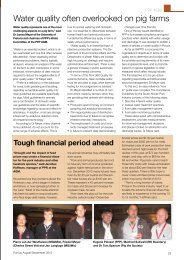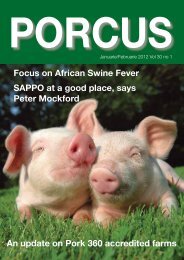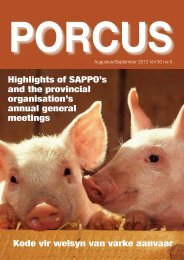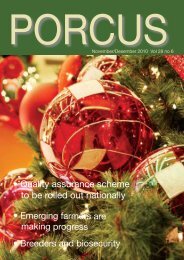You also want an ePaper? Increase the reach of your titles
YUMPU automatically turns print PDFs into web optimized ePapers that Google loves.
SAPPO’s ten<br />
recommended<br />
biosecurity<br />
measures for<br />
pig farms<br />
1. Fence your piggery effectively to<br />
prevent access by people and animals.<br />
If possible prevent animals being able to<br />
dig under the fence.<br />
2. Don’t allow other types of animals or<br />
pets within your piggery fence.<br />
3. Don’t allow visitors into your piggery<br />
if they have been in contact with other<br />
pigs the past two days.<br />
4. You should provide all visitors with<br />
overalls and boots before entering your<br />
farm. They must leave these overalls and<br />
boots on your farm when they leave.<br />
5. Don’t allow people to eat within the<br />
piggery and especially not to bring pork<br />
or pork products into the piggery.<br />
6. Make sure that vehicles and goods<br />
you bring into your piggery are not a<br />
risk. Always disinfect vehicles and goods<br />
before they enter the piggery.<br />
7. Only bring pigs in from a piggery,<br />
which have a known disease status.<br />
International<br />
Water contaminated?<br />
Bottle water produced in the<br />
northern Gyeonggi Province of<br />
South Korea may be contaminated<br />
with the foot-and-mouth<br />
disease (FMD) virus plus other<br />
harmful organic substances, says<br />
an environmental group.<br />
According to the Citizens’ Institute for<br />
animal HealtH<br />
What is biosecurity?<br />
Biosecurity on pig farms is a<br />
set of protocols and standards<br />
designed to reduce the risk of<br />
diseases not present within<br />
the pig population from entering<br />
the pig farm and preventing<br />
diseases within the pig<br />
population from leaving the<br />
unit and infecting other pig<br />
farms.<br />
The basis of biosecurity measures is<br />
demarcating the biosecure unit with<br />
a physical barrier and then restrict-<br />
That piggery’s health status should be<br />
the same or better than your piggery’s<br />
status. Never bring pigs from auction<br />
facilities into your piggery.<br />
8. Do not feed swill (including dead<br />
poultry, poultry offal and animal offal).<br />
The use of vegetables is not a risk but<br />
feeding meat products to pigs is risky.<br />
9. Dead pigs must be disposed of so<br />
that they do not pose a possible source<br />
of disease to pigs outside of your piggery<br />
and must not be used for human<br />
Environmental Studies, 32 FMD burial<br />
sites for more than 23 000 pigs and<br />
cows were made near four drinking<br />
plants in Pocheon and Yeoncheon. The<br />
plants in those areas produce bottle<br />
water by purifying underground water.<br />
The group has urged the government to<br />
launch a full-scale inspection into FMD<br />
burial sites to check whether polluted<br />
fl uid leaked from the sites and penetrated<br />
into underground water sources.<br />
Federal data show meat and poultry<br />
safe, says AMI<br />
The recently published Pew<br />
study misleads consumers about<br />
the public health signifi cance of<br />
Staphylococcus aureus from food<br />
sources, says the American Meat<br />
Institute (AMI).<br />
A new Pew Commission-funded study<br />
misleads consumers about US meat<br />
and poultry, which is among the safest<br />
in the world, according to AMI. Authors<br />
of the new study, which involved a small<br />
number of samples from retail stores,<br />
claim that their fi ndings suggest that a<br />
signifi cant public health risk exists. However,<br />
federal data from the Centers for<br />
Disease Control and Prevention (CDC)<br />
show steady declines in foodborne illnesses<br />
linked to consumption of meat<br />
and poultry overall and indicate that<br />
human infections with Staphylococcus<br />
aureus (“Staph”) comprise less than one<br />
percent of total foodborne illnesses.<br />
ing access through the barrier. Thus,<br />
only essential people, animals and<br />
goods are allowed into the unit.<br />
Furthermore, anything entering<br />
the unit is disinfected and its origin<br />
carefully controlled to reduce the risk<br />
of it bringing a disease into the unit.<br />
Feeding of any swill is strictly<br />
prohibited. Swill is any leftover food<br />
from the catering industry, including<br />
restaurants, hotels and hospitals,<br />
especially if it contains any form of<br />
meat.<br />
Dr Peter Evans<br />
consumption.<br />
10. If you think doing/allowing anything<br />
to happen in your piggery is a disease<br />
risk – don’t do it.<br />
These recommendations are available on<br />
SAPPO’s website www.sapork.com.<br />
400 SOW<br />
PIGGERY TO<br />
CLOSE!<br />
2ND HAND PIGGERY<br />
EQUIPMENT FOR SALE!<br />
PHONE LANCE ON<br />
(036) 488 1200 OR<br />
082 614 5623<br />
FMD in Taiwan<br />
A new outbreak of foot-andmouth<br />
disease has been discovered<br />
in Taipei.<br />
Dr Kwo-Ching Huang, the chief veterinary<br />
offi cer and deputy director general<br />
in Chinese Taipei said that 14 cases<br />
and 123 susceptible cases had been<br />
discovered.<br />
During the routine active FMD serological<br />
surveillance, NSP antibodies<br />
were detected on a pig farm.<br />
The investigation showed that all<br />
pigs on the farm were clinically healthy.<br />
Porcus April/May 2011 15







